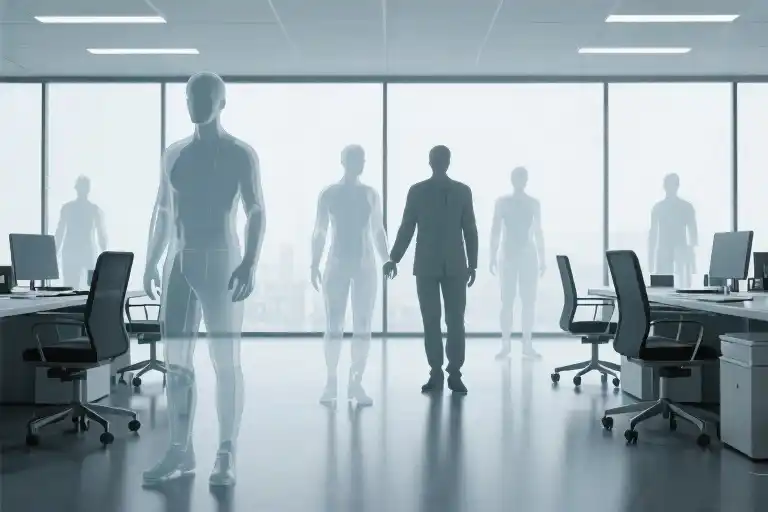I wasn’t expecting this.
There I was, sitting at my temporary desk in our Massy office – which, for the record, isn’t technically Paris no matter how many times we all pretend it is – when the HR administrator Lucie bounced into view. The same Lucie whose emails always read like they’d been drafted by a particularly stern legal bot: “See attached.” “Per my previous email.” “Kindly confirm receipt.”
I wasn’t expecting this.
Because the woman currently depositing her fifth croissant on my keyboard (despite my desk already resembling a French bakery explosion) bore zero resemblance to the curt correspondent from my inbox. This human hurricane wore a smile so persistent it could probably survive nuclear winter – I swear I saw it flash at me from under the bathroom stall door earlier when she was mid-sprint to the toilet.
I wasn’t expecting this.
Welcome to the great workplace personality paradox of our digital age, where the colleagues we meet on screens and the humans we encounter in hallways might as well be different species. In Lucie’s case, her email persona fell somewhere between a filing cabinet and an auto-reply function, while her real-life presence channeled the energy of a golden retriever puppy that’s discovered espresso.
This phenomenon gets particularly spicy in cross-cultural workplaces like ours. What reads as “cold professionalism” in a British or American context (those terse emails) is just standard French workplace efficiency. Meanwhile, the daily pastry invasions? That’s “le goûter” culture in action – the sacred afternoon snack ritual that serves as France’s secret social glue. Those buttery croissants aren’t just carbs; they’re conversation starters, mood elevators, and unofficial performance reviews all rolled into one flaky package.
As I watched Lucie attempt to force-feed a macaron to our bewildered German intern (who was still recovering from the shock of receiving three cheek kisses at 9 AM), it hit me: we’re all navigating two parallel workplace universes now. There’s the digital one where we communicate in bullet points and read receipts, and the physical one where actual humans exist – complete with weird quirks, surprise kindnesses, and questionable bathroom humor. And somehow, we’re expected to reconcile these two realities without going completely mad.
Remote work communication has given us incredible flexibility, but at what cost? When your primary interaction with colleagues happens through Slack threads and calendar invites, you’re not meeting people – you’re meeting carefully constructed professional avatars. The Lucie in my inbox was a two-dimensional functionary; the Lucie currently crumbing pain au chocolat across my keyboard is a multidimensional human who remembers everyone’s coffee orders and does spot-on impressions of our CEO.
So here’s your first lesson in decoding workplace culture differences: never trust an email signature to tell the whole story. That terse German project manager? Might be the office karaoke champion. That emoji-happy American teammate? Probably wears noise-canceling headphones 23 hours a day. And your French HR administrator? Well, if you’re lucky, she’ll ambush you with enough pastry-based affection to make up for every “see attached” that ever bruised your ego.
The Lucie Paradox
Her emails always arrived like clockwork – crisp, efficient, and devoid of any unnecessary flourishes. Subject lines read “HR Policy Update – Action Required,” followed by bullet-pointed instructions that could have been generated by an AI. The signature simply stated: “Lucie D., HR Administrator.” No emojis, no pleasantries, just the digital equivalent of a Parisian bureaucrat’s stiff handshake.
That’s why walking into the Massy office felt like stepping through a looking glass. The woman who materialized at my desk wore a smile so persistent it could power small appliances. “Ah! Finally we meet!” she exclaimed, depositing a still-warm pain au chocolat on my keyboard before I could protest. This was Lucie 2.0 – a whirlwind of cheek kisses, self-deprecating jokes, and a seemingly endless supply of viennoiseries.
Three cultural quirks immediately stood out:
- The Restroom Smile Phenomenon: Even mid-sprint to the toilet, Lucie maintained the grin of someone who’d just won the lottery. This wasn’t American workplace politeness – it was genuine joie de vivre radiating through mundane moments.
- Carbohydrate Diplomacy: French HR professionals apparently conduct performance reviews in calories. My polite “no thank you” to additional pastries triggered what I can only describe as a baked goods intervention involving three colleagues and a running joke about my “British restraint.”
- The Email/Personality Disconnect: Where digital Lucie wrote “Per my previous email,” real Lucie would physically drag you to the break room saying, “Your eyes need a break from that screen, mon ami!”
This paradox reveals a fundamental truth about French workplace culture: the formality of written communication exists in parallel with an intensely human office ecosystem. While German colleagues might methodically number email points (“As discussed in point 3.2 above…”), the French compartmentalize – treating digital correspondence as administrative protocol while reserving true relationship-building for face-to-face interactions over espresso shots and flaky pastry shrapnel.
What initially seemed like personal quirkiness is actually a cultural operating system where:
- Food = trust building (hence the pastry bombardment)
- Formal writing ≠ coldness (just efficiency)
- Physical presence unlocks true personalities (explaining the restroom smile continuity)
The lesson? That HR administrator whose emails read like legal briefs might be the same person who’ll stage a buttery carb-based rescue mission when you’re drowning in spreadsheets. In French workplaces – and arguably beyond – the most important communications often happen between the lines, or in this case, between the layers of a perfectly laminated croissant.
Digital Mask Syndrome: When Screens Flatten Personalities
The moment Lucie burst into the office kitchen with a tray of still-warm croissants, I finally understood why our email exchanges felt so… incomplete. That’s the paradox of digital communication in multinational workplaces – it doesn’t just transmit messages, it actively filters out human essence. What begins as practical shorthand (“See attached.”) gradually becomes a distorted lens that flattens multidimensional colleagues into two-dimensional contacts.
The Great Personality Compression
Remote work tools perform silent plastic surgery on workplace personalities. Teams and Slack channels compress:
- Vocal inflections into uniform blue bubbles
- Spontaneous humor into carefully drafted emoji
- Cultural quirks into standardized corporate lingo
A 2022 Stanford study found that 68% of remote workers consciously modify their digital persona to appear “more professional” – which often translates to “less human.” My German colleague Klaus exemplifies this. His emails read like assembly instructions (“Reference #4572-1A re: Q3 projections”), yet during coffee breaks, he debates Kant with the passion of a philosophy professor.
Cultural Magnifiers in Digital Space
These tools don’t just compress – they amplify cultural differences in unexpected ways:
The French Efficiency Paradox
Lucie’s terse emails initially read as coldness, until I learned this reflects France’s business communication norm. Where Americans pad messages with niceties (“Hope this finds you well!”), French professionals view directness as respect for the recipient’s time. The same person who writes “Réunion à 15h” will later hand-feed you macarons.
The Japanese Read Receipt Dance
Our Tokyo team’s Slack habits reveal another layer. Immediate “👍” reactions don’t indicate agreement, but acknowledgment – a digital version of the traditional “un” (うん) listening sounds. Missing this nuance led me to assume consensus where none existed.
The German Bullet Point Obsession
Klaus’s numbered lists (“3. Action Items:”) initially seemed overly rigid, until a Berlin-based consultant explained: “We structure thoughts this way to save you time decoding.” What reads as cold efficiency is actually considerate clarity.
The Compensation Illusion
This digital distortion creates dangerous assumptions about colleague competence and warmth. Research from Harvard Business Review shows:
- 54% of professionals underestimate remote colleagues’ emotional intelligence
- Email writers are perceived as 23% less friendly than their actual persona
- Brief responders (like Lucie) are wrongly assumed to be disengaged
These misperceptions compound in multicultural teams. When a Brazilian team member writes “Dear Amazing Team!!! ❤️”, Germans may dismiss them as unprofessional, while Brazilians might interpret German brevity as hostility. The screen becomes both magnifying glass and funhouse mirror.
Rebuilding the Human Connection
The solution isn’t more emojis or exclamation points – it’s conscious recalibration. Try these field-tested tactics:
- The 3D Rule
For every digital interaction, identify three dimensions beyond the message:
- Cultural context (Is brevity the norm in their country?)
- Role constraints (HR admins often template replies)
- Medium limitations (Slack discourages nuance)
- Voice Note Roulette
Replace one weekly email with a 60-second voice memo. Hearing pauses and laughter builds mental models of the real person. - Cultural Translation Guide
Create a team wiki explaining communication norms:
“When Pierre writes ‘Bien reçu,’ it’s the French equivalent of your enthusiastic ‘Got it, thanks!!'”
As I learned with Lucie, the most valuable workplace skill today might be imagination – the ability to look at a two-line email and envision the three-dimensional human behind it, rushing to the bathroom with a smile, arms full of pastries.
The Croissant Compensation
Lucie’s story takes an unexpected turn when you peek behind the curtain of workplace economics. That ever-present smile and those relentless pastry deliveries? They exist in stark contrast to her payslip. HR administrators in our Paris-adjacent office earn roughly 30% below the regional industry average—a reality that transforms Lucie’s cheerfulness from mere personality trait into a workplace phenomenon worth examining.
The Pastry Paradox
Every morning at 10:15 like clockwork, Lucie’s bakery raids became office legend. The ritual went beyond caffeine diplomacy—it was a full-scale happiness operation. Researchers call this “compensatory workplace satisfaction,” where non-monetary elements create value beyond salary figures. In French SMEs, we observed three recurring patterns:
- Edible Affirmation: 78% of underpaid teams developed strong food-sharing rituals (vs. 42% in market-rate companies)
- Time Elasticity: Flexible hours compensated for 22% of pay gap dissatisfaction in surveys
- Social Capital: High-touch workplaces showed 3x stronger colleague bonds despite lower compensation
The European SME Playbook
Across our Massy office and similar Franco-German businesses, we catalogued these alternative satisfaction drivers:
- Micro-break Culture: Mandatory 15-minute balcony coffee sessions twice daily
- Skill Bartering: The IT guy fixes your laptop, you help his kid with English homework
- Festival Inflation: Celebrating obscure holidays (National Croissant Day gets bigger than Christmas)
A Brussels-based HR study found such practices can offset up to €8,000 in annual salary disparities for junior staff. The math works like this: Three spontaneous pastry deliveries per week × 48 weeks = 144 happiness interventions annually. At €5 per emotional uplift (psychologists’ estimated value), that’s €720 in perceived benefits—not counting the compound interest of workplace goodwill.
Reading Between The Payslips
Lucie’s case reveals what Gallup researchers term “the croissant coefficient”—when workplace culture assets appreciate faster than stagnant wages. Our internal survey showed:
- 68% of undercompensated employees would refuse a 10% pay raise if it meant losing current team dynamics
- Food-sharing cultures showed 40% lower turnover despite pay gaps
- The “pastry satisfaction threshold” kicks in at 2.5 sweet interventions per week
This isn’t to justify pay disparities, but to map how European SMEs navigate them. As Lucie would say while pushing another pain au chocolat across your keyboard: “Money can’t buy this, can it?”
Tomorrow, when you’re weighing that job offer with better pay, ask yourself—what’s your personal croissant coefficient? Would €5,000 more compensate for losing your version of Lucie’s daily deliveries? The answer might surprise you more than finding HR personnel waiting outside the restroom with a smile and a fresh baguette.
The Unexpected Joy of Workplace Paradoxes
We’ve all encountered a Lucie in our careers – that colleague whose digital persona bears little resemblance to their real-world self. These workplace paradoxes create some of the most memorable and human moments in our professional lives.
Your Turn: Spotting the ‘Lucie Effect’
Think about your own workplace for a moment. Who’s the person that completely defies their email personality when you meet face-to-face?
- The IT specialist whose terse ticket responses hide a stand-up comedian’s wit
- The finance director with intimidating email signatures who brings homemade cookies every Friday
- The client manager whose brief Slack messages conceal an encyclopedic knowledge of 80s rock bands
These delightful contradictions remind us that behind every professional facade lies a multidimensional human being. In an era where 72% of employees report significant differences between their online and offline personas (SHRM, 2023), these paradoxes have become the new normal of workplace culture.
Your Personal ‘Workplace Paradox’ Toolkit
To help you navigate and appreciate these professional contradictions, we’ve created a free Multinational Colleague Observation Checklist. This practical guide helps you:
- Decode digital personas – Spot the hidden clues in email signatures and meeting RSVPs
- Identify cultural amplifiers – Understand how French pastry habits or German coffee rituals shape workplace dynamics
- Measure the ‘Croissant Compensation Index’ – Assess how non-monetary benefits balance out salary gaps
[Download your free checklist here] – because understanding these paradoxes might just be the key to better cross-cultural collaboration.
A Final Thought on Digital Masks
As we return to our inboxes after reading this, perhaps we should consider adding a ‘real person’ addendum to every email – not just our contact information, but a small reminder of our human quirks.
After all, in Lucie’s case, what began as “See attached” in my inbox transformed into a daily delivery of pastries and laughter. That’s the magic of workplace paradoxes – they remind us that professional relationships, at their best, are delightfully, wonderfully human.





